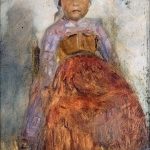Bertha Wegmann, a Danish portrait painter, was born on October 17, 1847, in Sognekirke, Denmark. Renowned for her skillful and insightful portraiture, Wegmann achieved acclaim during the late 19th and early 20th centuries, becoming one of Denmark’s prominent female artists. Her contributions to the art world extended beyond her canvas, challenging gender norms and inspiring subsequent generations of women artists.
Wegmann’s artistic journey began with early exposure to the arts and an innate passion for drawing. Encouraged by her family, she pursued her artistic inclinations, eventually enrolling at the Women’s Art School in Copenhagen in 1868. Wegmann’s decision to pursue art education was a significant choice at a time when societal expectations often limited women’s access to formal artistic training.
In 1872, Wegmann continued her studies at the Royal Danish Academy of Fine Arts, where she honed her technical skills under the guidance of prominent artists such as Wilhelm Marstrand and Frederik Vermehren. Despite being one of the few women admitted to the academy, Wegmann’s talent quickly garnered recognition, and she received several awards for her work.
Wegmann’s early works showcased her proficiency in portraiture and a keen ability to capture the individuality of her subjects. She demonstrated a nuanced understanding of facial expressions and an acute awareness of the psychological depth inherent in portraiture. Wegmann’s artistry extended beyond mere representation; her portraits conveyed the inner thoughts and emotions of the sitters.
In the 1870s and 1880s, Wegmann established herself as a sought-after portrait painter, receiving commissions from prominent Danish figures. Her clientele included members of the Danish royal family, aristocracy, and influential individuals from the cultural and social spheres. Wegmann’s success as a portraitist was grounded in her ability to establish a rapport with her subjects, creating intimate and engaging portrayals.
One of Wegmann’s notable portraits from this period is the depiction of her close friend, the Danish author and women’s rights advocate Mathilde Fibiger. The portrait captured Fibiger’s strength and intellectual presence, reflecting both the subject’s personality and Wegmann’s feminist sensibilities. Wegmann’s involvement in the women’s rights movement aligned with her commitment to challenging societal norms through her art.
Wegmann’s participation in the burgeoning women’s rights movement in Denmark marked her engagement with broader social issues. She associated with leading feminists and contributed illustrations to the feminist magazine “Nyt Tidsskrift” (New Journal), further integrating her art with her advocacy for gender equality. Wegmann’s involvement in both artistic and feminist circles demonstrated her belief in the power of art to influence social change.
In the 1880s, Wegmann spent time in Paris, a thriving center of artistic innovation. Her exposure to the Parisian art scene, including the Impressionist movement, left a lasting impact on her work. Wegmann incorporated elements of Impressionism into her portraiture, experimenting with light, color, and brushstroke to convey a sense of immediacy and vibrancy in her paintings.
Wegmann’s time in Paris also allowed her to study under the renowned portrait painter Carolus-Duran. Under his tutelage, she refined her technique and gained insights into the evolving trends in portraiture. Wegmann’s willingness to explore new artistic approaches demonstrated her adaptability and openness to artistic influences beyond Denmark.
Upon returning to Denmark, Wegmann continued to receive acclaim for her portraiture. She established a studio in Copenhagen and became a central figure in the city’s cultural life. Her portraits captured the essence of Danish society, portraying individuals from various walks of life with empathy and insight. Wegmann’s ability to transcend social boundaries through her art reinforced her position as a trailblazer in the Danish art scene.
Wegmann’s commitment to promoting women in the arts extended to her role as a teacher. In 1888, she became a drawing teacher at the Women’s Art School in Copenhagen, contributing to the education and professional development of aspiring female artists. Her impact as a teacher went beyond imparting technical skills; Wegmann served as a mentor and advocate for women pursuing artistic careers.
In 1891, Wegmann became the first woman to be elected a member of the Royal Danish Academy of Fine Arts. This milestone marked a historic moment in the acknowledgment of women’s contributions to the arts in Denmark. Wegmann’s achievements challenged entrenched gender barriers and paved the way for future generations of women artists to be recognized within institutional frameworks.
Wegmann’s later years were marked by continued artistic output and recognition. She received prestigious awards, including the Prince Eugen Medal in 1911, which acknowledged her significant contributions to the arts. Wegmann’s portraits continued to capture the evolving social landscape of Denmark, reflecting the changing roles and identities of individuals in the early 20th century.
Bertha Wegmann passed away on February 4, 1926, leaving behind a legacy as a groundbreaking artist, feminist, and educator. Her enduring influence on Danish portraiture and her advocacy for women in the arts continue to be celebrated. Wegmann’s ability to navigate both artistic and societal realms exemplifies her resilience and determination in pursuing a career that defied gender norms.
Wegmann’s legacy extends beyond her individual achievements; she contributed to a broader shift in attitudes toward women in the arts. Her pioneering spirit, commitment to artistic excellence, and advocacy for gender equality have solidified her place as a trailblazer in the annals of Danish art history. Bertha Wegmann’s life and work stand as a testament to the transformative power of art and its capacity to challenge societal expectations and inspire change.






